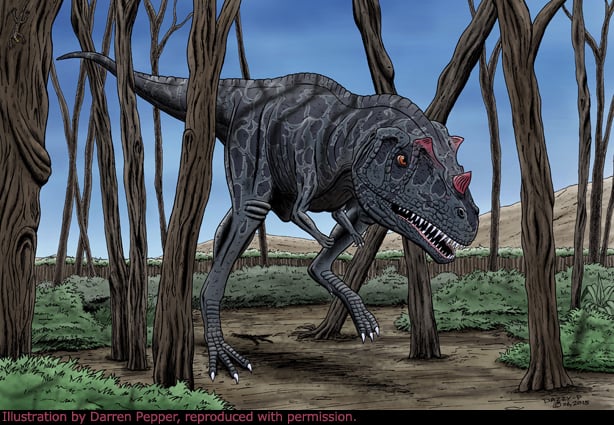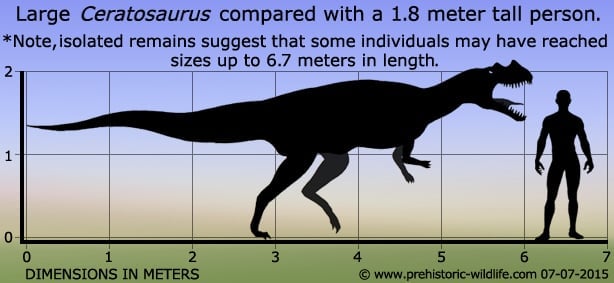In Depth
Ceratosaurus has been known to science since towards the end of the nineteenth century, and thanks to its head ornamentation, has long been one of the most popular. Early on, Othniel Charles Marsh considered the blade like nasal horn to have been a weapon against other dinosaurs, but this is no longer considered likely, especially when you compare Ceratosaurus to other theropod dinosaurs that had head crests such as Dilophosaurus, Monolophosaurus and Guanlong which are all more likely for a visual display purpose. Ceratosaurus also possessed a pair of smaller crests above its eyes that were extensions of the lacrimal bones.
The distinctive nasal horn of Ceratosaurus was made from an extension of the nasal bones at the snout of the skull. The horn itself is not a single growth but the fusing of two growths from separate bones. A juvenile specimen also features the beginnings of the horn from these two bones that have not yet fused together, possibly indicating that the nasal horn, when grown, was a sign of reproductive maturity.
Another interesting feature that seems to make Ceratosaurus unique among the theropods was the osteoderms that ran down its back. The purpose for these is not exactly known. Osteoderms are often evolved as a form of defence and if this were the case with Ceratosaurus, then that could suggest that there were other larger predators at the time (possibly those like Saurophaganax) that would not think twice about attacking Ceratosaurus. It may have also been for extra defence in intraspecific combat with rivals. The tail of Ceratosaurus was quite flexible and supported by high vertebral spines. It has been suggested that if Ceratosaurus ever took to the water, the tail would have been a very powerful swimming aid, used in a similar fashion as a crocodiles.
Ceratosaurus is the type genus of the Ceratosauridae group of theropod dinosaurs.

Further Reading
– Principal characters of American Jurassic dinosaurs. Part VIII. The order Theropoda. – The American Journal of Science, series 3 27:329-340. – Othniel Charles Marsch – 1884. – Restorations of Claosaurus and Ceratosaurus. – American Journal of Science 44 (262): 343–349. – Othiel Charles Marsh – 1892. – Osteology of the carnivorous Dinosauria in the United States National Museum, with special reference to the genera Antrodemus (Allosaurus) and Ceratosaurus. – Bulletin of the United States National Museum 110: 1–154. – C. W. Gilmore – 1920. – Ceratosaurus (Dinosauria, Theropoda): A Revised Osteology. – Utah Geological Survey. pp. 1–80. – J. H. Madsen & S. P. Welles – 2000. – A reanalysis of the phylogenetic affinties of Ceratosaurus (Theropoda, Dinosauria) based on new specimens from Utah, Colorado, and Wyoming. – Journal of Vertebrate Paleontology. 20. – B. B. Britt, D. J. Chure, T. R. Holtz Jr, C. A. Miles & K. L. Stadtman – 2000. – Ceratosaurus sp. (Dinosauria: Theropoda) in the Late Jurassic of Portugal. – 31st International Geological Congress. Rio de Janeiro, Brazil. – O. Mateus & M. T. Antunes – 2015. – New information on the forearm and manus of Ceratosaurus nasicornis Marsh, 1884 (Dinosauria, Theropoda), with implications for theropod forelimb evolution. – Journal of Vertebrate Paleontology. 36 (2). – M. T. Carrano & J. Choiniere – 2016.











